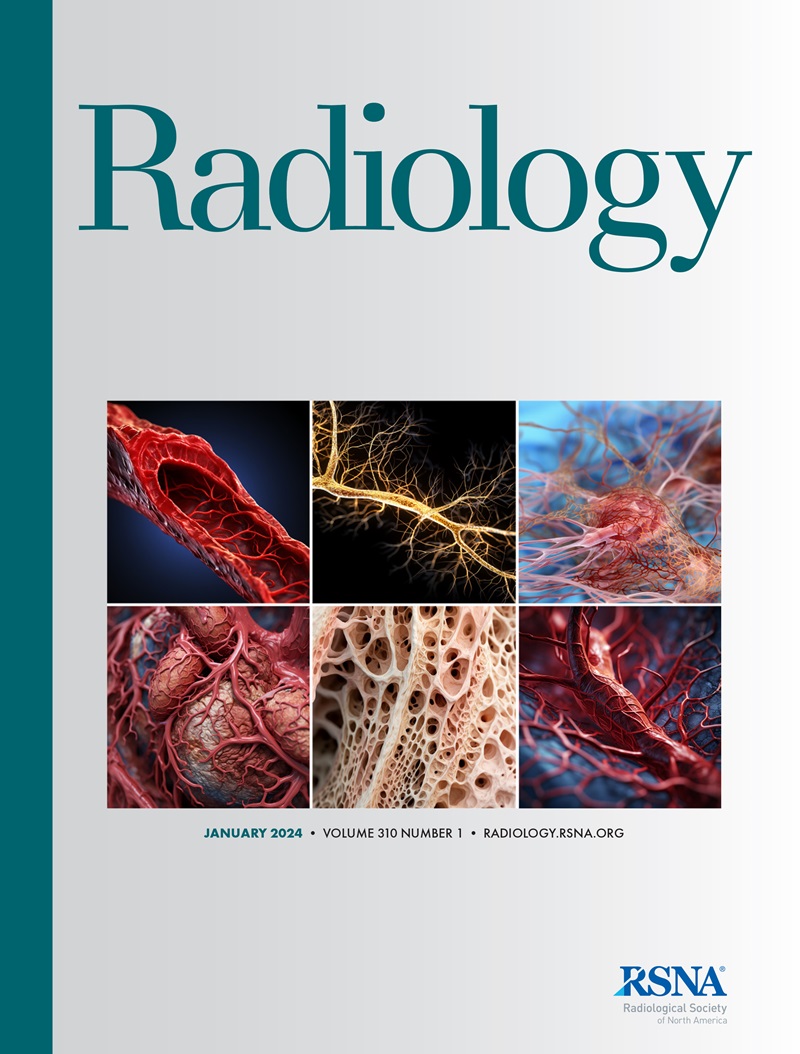Posttreatment MRI to Predict Pathologic Complete Response of Triple-Negative Breast Cancer to Neoadjuvant Chemoimmunotherapy.
IF 15.2
1区 医学
Q1 RADIOLOGY, NUCLEAR MEDICINE & MEDICAL IMAGING
Toulsie Ramtohul, Derek Lollivier, Justine Spriet, Maxime Jin, Lounes Djerroudi, Thomas Gaillard, Claire Bonneau, Delphine Loirat, Diana Bello-Roufai, Youlia Kirova, Pierre Loap, Caroline Malhaire, Anne Vincent Salomon, François-Clément Bidard, Anne Tardivon, Audrey Maillez, Lauren Wallaert, Luc Ceugnart, Caroline Nhy, Luc Cabel
求助PDF
{"title":"Posttreatment MRI to Predict Pathologic Complete Response of Triple-Negative Breast Cancer to Neoadjuvant Chemoimmunotherapy.","authors":"Toulsie Ramtohul, Derek Lollivier, Justine Spriet, Maxime Jin, Lounes Djerroudi, Thomas Gaillard, Claire Bonneau, Delphine Loirat, Diana Bello-Roufai, Youlia Kirova, Pierre Loap, Caroline Malhaire, Anne Vincent Salomon, François-Clément Bidard, Anne Tardivon, Audrey Maillez, Lauren Wallaert, Luc Ceugnart, Caroline Nhy, Luc Cabel","doi":"10.1148/radiol.243824","DOIUrl":null,"url":null,"abstract":"<p><p>Background Neoadjuvant chemoimmunotherapy (NACI) has substantially improved pathologic complete response (pCR) rates in early triple-negative breast cancer (TNBC). However, the predictive accuracy of posttreatment MRI remains unexplored. Purpose To assess the performance of posttreatment MRI in the prediction of pCR in participants with TNBC treated with NACI. Materials and Methods In this prospective multicenter study (August 2021-June 2024), women with early TNBC were recruited from three centers (training set: Institut Curie; test set: Institut Godinot and Institut Oscar Lambret). Post-NACI dynamic contrast-enhanced MRI scans from multiple vendors were analyzed. Radiologic complete response (rCR)-defined as no enhancement in the tumor bed-was evaluated for predicting pCR. A multivariable logistic regression model incorporating rCR, nodal involvement, and Ki-67 index was developed and externally validated. In cases with residual enhancement (non-rCR), a radiomic score using shape and first-order features was tested. Results A total of 175 women were included in the training set (mean age, 49 years ± 11 [SD]) and 84 women in the external test set (mean age, 52 years ± 12). The rCR at MRI was predictive of pCR, with an area under the receiver operating characteristic curve (AUC) of 0.83 (95% CI: 0.75, 0.92). The combined model (rCR + nodal status + Ki-67) yielded an AUC of 0.88 (95% CI: 0.81, 0.96) in the test set. In node-negative patients with Ki-67 greater than 30%, the rCR false-discovery rate (ie, the proportion of rCR cases that were actually non-pCR or residual disease missed at breast MRI) was 3.6% (two of 56) in the training set and 3.5% (one of 29) in the test set; all cancers were limited to residual cancer burden I. In non-rCR cases, a model incorporating the radiomics score and lesion count achieved an AUC of 0.80 (95% CI: 0.69, 0.90). Conclusion Posttreatment rCR at MRI demonstrated strong predictive value for pCR in early TNBC following NACI. © RSNA, 2025 <i>Supplemental material is available for this article.</i> See also the editorial by Onishi in this issue.</p>","PeriodicalId":20896,"journal":{"name":"Radiology","volume":"316 1","pages":"e243824"},"PeriodicalIF":15.2000,"publicationDate":"2025-07-01","publicationTypes":"Journal Article","fieldsOfStudy":null,"isOpenAccess":false,"openAccessPdf":"","citationCount":"0","resultStr":null,"platform":"Semanticscholar","paperid":null,"PeriodicalName":"Radiology","FirstCategoryId":"3","ListUrlMain":"https://doi.org/10.1148/radiol.243824","RegionNum":1,"RegionCategory":"医学","ArticlePicture":[],"TitleCN":null,"AbstractTextCN":null,"PMCID":null,"EPubDate":"","PubModel":"","JCR":"Q1","JCRName":"RADIOLOGY, NUCLEAR MEDICINE & MEDICAL IMAGING","Score":null,"Total":0}
引用次数: 0
引用
批量引用
Abstract
Background Neoadjuvant chemoimmunotherapy (NACI) has substantially improved pathologic complete response (pCR) rates in early triple-negative breast cancer (TNBC). However, the predictive accuracy of posttreatment MRI remains unexplored. Purpose To assess the performance of posttreatment MRI in the prediction of pCR in participants with TNBC treated with NACI. Materials and Methods In this prospective multicenter study (August 2021-June 2024), women with early TNBC were recruited from three centers (training set: Institut Curie; test set: Institut Godinot and Institut Oscar Lambret). Post-NACI dynamic contrast-enhanced MRI scans from multiple vendors were analyzed. Radiologic complete response (rCR)-defined as no enhancement in the tumor bed-was evaluated for predicting pCR. A multivariable logistic regression model incorporating rCR, nodal involvement, and Ki-67 index was developed and externally validated. In cases with residual enhancement (non-rCR), a radiomic score using shape and first-order features was tested. Results A total of 175 women were included in the training set (mean age, 49 years ± 11 [SD]) and 84 women in the external test set (mean age, 52 years ± 12). The rCR at MRI was predictive of pCR, with an area under the receiver operating characteristic curve (AUC) of 0.83 (95% CI: 0.75, 0.92). The combined model (rCR + nodal status + Ki-67) yielded an AUC of 0.88 (95% CI: 0.81, 0.96) in the test set. In node-negative patients with Ki-67 greater than 30%, the rCR false-discovery rate (ie, the proportion of rCR cases that were actually non-pCR or residual disease missed at breast MRI) was 3.6% (two of 56) in the training set and 3.5% (one of 29) in the test set; all cancers were limited to residual cancer burden I. In non-rCR cases, a model incorporating the radiomics score and lesion count achieved an AUC of 0.80 (95% CI: 0.69, 0.90). Conclusion Posttreatment rCR at MRI demonstrated strong predictive value for pCR in early TNBC following NACI. © RSNA, 2025 Supplemental material is available for this article. See also the editorial by Onishi in this issue.
治疗后MRI预测三阴性乳腺癌对新辅助化疗免疫治疗的病理完全反应。
背景:新辅助化疗免疫治疗(NACI)大大提高了早期三阴性乳腺癌(TNBC)的病理完全缓解(pCR)率。然而,治疗后MRI的预测准确性仍有待探索。目的评价经NACI治疗的TNBC患者术后MRI预测pCR的效果。材料和方法在这项前瞻性多中心研究(2021年8月- 2024年6月)中,从三个中心招募了早期TNBC女性(训练集:居里研究所;测试组:Godinot研究所和Oscar Lambret研究所)。分析了来自多个供应商的naci后动态对比增强MRI扫描。评估放射学完全缓解(rCR)-定义为肿瘤床无强化-用于预测pCR。建立了包含rCR、节点参与和Ki-67指数的多变量logistic回归模型并进行了外部验证。在残余增强(非rcr)的情况下,使用形状和一阶特征测试放射学评分。结果175名女性被纳入训练组(平均年龄49岁±11 [SD]), 84名女性被纳入外部测试组(平均年龄52岁±12)。MRI rCR可预测pCR,受试者工作特征曲线下面积(AUC)为0.83 (95% CI: 0.75, 0.92)。联合模型(rCR +淋巴结状态+ Ki-67)在测试集中的AUC为0.88 (95% CI: 0.81, 0.96)。在Ki-67大于30%的淋巴结阴性患者中,rCR假发现率(即在乳腺MRI中未发现实际非pcr或残留疾病的rCR病例的比例)在训练集中为3.6%(56例中的2例),在测试集中为3.5%(29例中的1例);在非rcr病例中,结合放射组学评分和病变计数的模型的AUC为0.80 (95% CI: 0.69, 0.90)。结论MRI治疗后rCR对NACI后早期TNBC的pCR具有较强的预测价值。©RSNA, 2025本文可获得补充材料。另见大西在本期的社论。
本文章由计算机程序翻译,如有差异,请以英文原文为准。

 求助内容:
求助内容: 应助结果提醒方式:
应助结果提醒方式:


